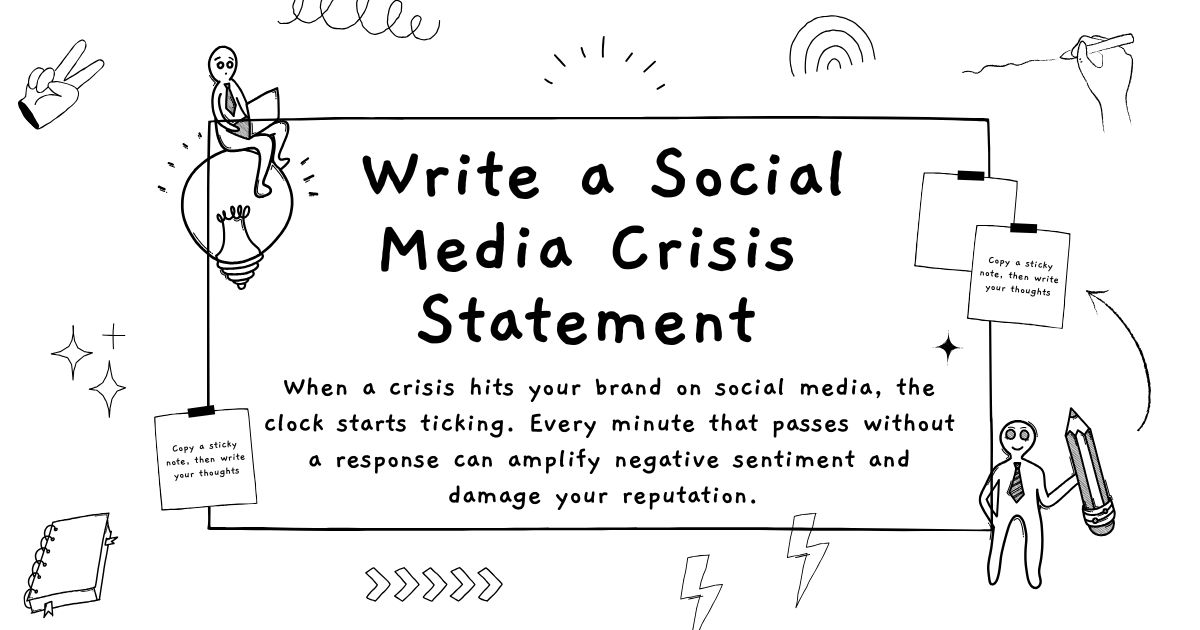
When a crisis hits your brand on social media, the clock starts ticking. Every minute that passes without a response can amplify negative sentiment and damage your reputation. A well-crafted crisis statement can be the difference between recovery and long-term brand damage.
Social media crises can escalate within hours, reaching thousands or even millions of people before you have a chance to respond. The key to effective crisis management lies in preparation, swift action, and clear communication. This guide will walk you through the essential steps to create a social media crisis statement that protects your brand and helps restore trust with your audience.
Understanding Social Media Crisis Communication
A social media crisis statement serves as your brand’s official response to a negative situation that has gained traction online. Unlike traditional PR statements, social media crisis communications must be concise, immediate, and tailored to the platform where the crisis originated.
Crisis statements on social media require a different approach than formal press releases. They need to feel authentic and human while maintaining professionalism. The tone should match your brand voice while acknowledging the seriousness of the situation.
Types of Social Media Crises
Before crafting your statement, identify the type of crisis you’re facing:
Product or Service Issues: Defects, safety concerns, or service outages that affect customers directly.
Employee Misconduct: Inappropriate behavior by staff members that reflects poorly on the company.
Miscommunication: Poorly worded posts, cultural insensitivity, or messages taken out of context.
External Associations: Negative publicity from partnerships, suppliers, or third-party relationships.
Data Breaches: Security incidents that compromise customer information or privacy.
Each type requires a slightly different approach in your response strategy.
Essential Elements of an Effective Crisis Statement
Acknowledge the Issue Quickly
Speed matters in crisis communication. Acknowledge the situation within hours, not days. Even if you don’t have all the details, a brief acknowledgment shows you’re aware and taking the matter seriously.
Your initial response might be: “We’re aware of the concerns raised about [specific issue] and are investigating the matter thoroughly. We’ll provide an update as soon as we have more information.”
Take Responsibility When Appropriate
If your organization is at fault, own up to it. Avoid making excuses or deflecting blame. Taking responsibility demonstrates integrity and helps rebuild trust faster than defensive responses.
Use clear, direct language: “We made a mistake” rather than “mistakes were made.” Active voice shows accountability and leadership.
Express Genuine Empathy
Show that you understand how the situation affects your customers, employees, or community. Empathy helps humanize your brand and demonstrates that you care about the impact beyond just protecting your reputation.
Avoid generic apologies. Instead, acknowledge specific impacts: “We understand this situation has caused frustration for our customers who rely on our service daily.”
Outline Concrete Next Steps
Tell your audience exactly what you’re doing to address the issue. Vague promises to “do better” aren’t enough. Provide specific actions and timelines when possible.
Examples of concrete steps include:
- Conducting thorough investigations
- Implementing new policies or procedures
- Offering compensation or refunds
- Partnering with relevant organizations
- Providing regular updates on progress
Provide Contact Information
Make it easy for affected parties to reach you directly. Include relevant contact information such as customer service numbers, email addresses, or dedicated crisis communication channels.
This shows transparency and gives people an alternative to continuing the conversation publicly on social media.
Crafting Your Crisis Statement: Step-by-Step Process
Step 1: Gather the Facts
Before writing anything, collect all available information about the situation. Speak with relevant departments, review documentation, and understand the scope of the issue.
Create a timeline of events and identify key stakeholders who need to be informed or involved in the response.
Step 2: Define Your Key Messages
Determine the main points you need to communicate:
- What happened
- Who was affected
- What you’re doing about it
- How you’ll prevent it from happening again
Keep these messages consistent across all platforms and responses.
Step 3: Choose the Right Tone
Your tone should reflect both your brand personality and the seriousness of the situation. A crisis involving safety issues requires a more formal, serious tone than a minor service disruption.
Consider your audience’s emotional state. Are they angry, worried, or disappointed? Adjust your tone accordingly while remaining authentic to your brand.
Step 4: Write Multiple Versions
Create different versions of your statement for different platforms. Twitter requires brevity, while LinkedIn allows for more detailed explanations. Facebook posts can include more context and visual elements.
Each version should contain the same core messages but be optimized for the specific platform’s audience and format.
Step 5: Review and Approve
Have multiple stakeholders review your statement before publishing. Include legal, PR, and senior management in the approval process when necessary.
Check for clarity, accuracy, and potential misinterpretations. Read the statement aloud to ensure it sounds natural and genuine.
Platform-Specific Considerations
Twitter Crisis Responses
Twitter’s character limit requires concise messaging. Use threads for complex issues that need more explanation. Pin important crisis updates to the top of your profile.
Consider using Twitter’s reply feature to provide additional context to your main statement without cluttering the primary message.
Facebook Crisis Communication
Facebook allows for longer-form content and visual elements. Use this space to provide more detailed explanations and include relevant images or videos that support your message.
Facebook’s comment system requires active monitoring and response during crisis situations.
Instagram Crisis Management
Instagram’s visual nature means your crisis statement might need accompanying imagery. Choose images carefully to ensure they match the tone and seriousness of your message.
Use Instagram Stories for real-time updates and highlights to preserve important crisis communications.
LinkedIn Professional Response
LinkedIn audiences expect more formal, detailed communications. Use this platform for comprehensive statements that include business context and industry implications.
LinkedIn is particularly important for B2B companies facing crisis situations.
Common Mistakes to Avoid
Delaying Your Response
Silence during a crisis is often interpreted as indifference or guilt. Even if you don’t have all the answers, acknowledge the situation quickly and commit to providing updates.
Using Legal Jargon
Avoid overly technical or legal language that can make your statement feel impersonal or defensive. Use clear, everyday language that your audience can easily understand.
Making Promises You Can’t Keep
Only commit to actions you can realistically deliver. Overpromising and underdelivering will make the crisis worse and damage your credibility further.
Ignoring Negative Comments
Hiding or deleting negative comments often backfires and can make the situation worse. Instead, respond professionally and direct serious concerns to private channels when appropriate.
Inconsistent Messaging
Ensure all team members responding to the crisis use consistent key messages. Mixed messages confuse your audience and undermine your response efforts.
Crisis Statement Templates and Examples
Template for Product Issues
“We’re aware of reports regarding [specific product issue]. The safety and satisfaction of our customers is our top priority. We’re immediately [specific action being taken] and will provide updates as our investigation progresses. Customers affected by this issue can contact us at [contact information]. We apologize for any inconvenience and appreciate your patience as we work to resolve this matter.”
Template for Service Outages
“We’re experiencing technical difficulties with [specific service] that began at [time]. Our technical team is working to restore full service as quickly as possible. We understand how disruptive this is to your [work/plans/etc.] and sincerely apologize. We’ll post updates every [timeframe] until the issue is resolved. Current status: [brief update].”
Template for Miscommunication
“We recognize that our recent post about [topic] was inappropriate and hurtful. We sincerely apologize for this error in judgment. We’re reviewing our content approval process to prevent similar incidents. We’re committed to [specific action] and will share our progress. Thank you to those who brought this to our attention.”
Post-Crisis Communication Strategy
Follow-Up Updates
Keep your audience informed about progress on resolving the issue. Regular updates show ongoing commitment and help maintain trust during the recovery process.
Set expectations for when updates will be provided and stick to that schedule.
Lessons Learned
After the immediate crisis passes, share what you’ve learned and how you’re implementing changes to prevent similar issues. This demonstrates growth and continuous improvement.
Rebuilding Trust
Crisis recovery takes time. Continue demonstrating your values through actions, not just words. Consistent, positive interactions over time help rebuild damaged relationships.
Moving Forward: Prevention and Preparation

The best crisis statements are the ones you never have to use. Invest in crisis prevention through robust policies, employee training, and regular risk assessments.
Develop crisis communication templates in advance so you can respond quickly when issues arise. Create approval processes that balance speed with accuracy.
Build relationships with your social media community during good times. Strong relationships provide goodwill that can help during difficult situations.
Monitor social media mentions and sentiment regularly to catch potential issues before they become full-blown crises.
Remember that how you handle a crisis can ultimately strengthen your brand if done thoughtfully and authentically. Your response becomes part of your brand story and can demonstrate your values in action.



















No Comments